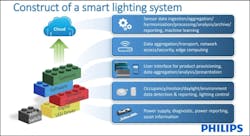This week, our team hosted Philips Lighting OEM product manager Al Marble, who presented a webcast on smart lighting. Marble confirmed our near-constant refrain that based on recent industry events and activity, 2018 appears to be “the year of connectivity.” But he added that connected smart lighting systems don’t have to overwhelm the parties involved. As he stated during the webcast introduction, understanding the components and functions of connected lighting can “help bring order to the chaos.” Following are four key points for starting off on a steady course with smart lighting.
1. Controls alone do not make a lighting system “smart.”
Marble stated right from the outset that controls have always been available for lighting, whether simple switches, dimmers, or sensors. What makes a system smart is combining devices with lighting hardware in a network that allows them to “talk” to each other — ultimately, to provide more granular management of the lighting and other building or municipal systems, in the case of an outdoor networked system. Manual control can still be enabled, but the objective is programmability as well as the ability for the system to learn how to manage all the components for smooth operation. Machine learning, artificial intelligence, smart city and asset management — call it whatever you like, and make the assigned tasks as simple or as complex as you need.
2. Standardization will stimulate adoption.
To get beyond illumination and enable the system management concepts explained above, components, interfaces, and the associated communications technology should become harmonized, Marble said. Interoperability, as the industry has observed before, will go a long way toward simplifying the development, installation, and management of smart lighting systems. Proprietary systems might seem like the easiest solution at first, but try putting multiple proprietary sub-systems together and see how well they communicate with each other. Another issue is how well those proprietary solutions will survive the inevitable advance of technology. And the necessary support from each vendor involved could come at a high cost. Allaying these concerns will stimulate the uptake of smart lighting technology.
3. Customers need quantifiable benefits to approve smart lighting.
During the webcast, Marble sourced a 2017 report from the DesignLights Consortium (DLC), which documented quantifiable energy savings of networked lighting controls for all types of lighting systems. This information has clearly informed the organization’s work on its Networked Lighting Controls (NLC) System Specification over the years, which was launched in 2015 and is on version 3.0 this year. Showing validated energy savings estimates may get decision makers over the speed bumps of “this is too much work/too complicated/too expensive.” And the NLC specification has formed the basis of the qualified products list that gates access to some rebates and incentives. And on that note…
4. Return on investment depends on multiple factors.
Although energy cost reduction itself has been the mainstay of discussions about lighting controls and balancing the cost of more intelligent systems, the associated rebates and incentives from utilities will help reduce payback time. However, Marble cautioned that you need to be aware of region-specific rebates. It’s also important to determine how much functionality you need to use, and what a future-proof system will look like in your application or project. A strong sense of current requirements versus future expectations will allow you to direct the project for maximum ROI. Beyond that, I’d also note that a lighting-as-a-service (LaaS) agreement could boost ROI for the customer while ensuring a sustainable business in the longer term.
I’ve touched on just a few points here. If you didn’t attend the live webcast, register for Al Marble’s on-demand presentation and get the full scope of his smart lighting perspective.






